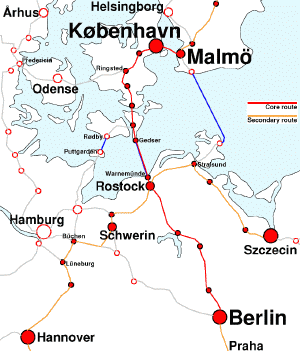More than 5 years ago, I developed an integrated traffic concept around the route Berlin – Warnemünde – Gedser – København – Malmö, and named it
Baltic Seatrain.
After responsibilities had changed within a railroad company interested in the operation, this work was put on hold.
Operating this traffic through Warnemünde is an interesting option, if considerably shorter travel time is provided in comparison to the alternative route via Puttgarden. With the concepts of important players not able to fulfill this goal, success was impossible. Decisive for stopping the project was the observation, that Mecklenburg-Vorpommern lacked the political power for achieving a 160 km/h track upgrade Rostock – Berlin, which had been lobbied for. Instead of 160 km/h, there will be a "160 km/h" upgrade. This means, that the speed is reached in press releases, but not on every part of the track. When this upgrade on the cheap is finished, the negotiators of the agreement will already have retired.
In this situation, honest advice to a railroad company has to be, that the traffic Berlin – København should be either left untouched, or routed via Puttgarden. I explained the best way for implementation of the latter in a notice to the administration in Schwerin. (Today, I would have to rework some of the timing and the rolling stock suggestion.)
While an implementation of "Baltic Seatrain" wasn't and isn't possible under the given circumstances, the route via Warnemünde would still an interesting one, if an adequate level of technological and organizational effort could be attracted. Below the level of technical phantasy, which was once invested by DSB and DSB Rederi into the Korsør – Nyborg railferry route, and without integrated technical solutions for train and ship, there is no reason to bother, though. Even with a real 160 km/h upgrade between Berlin and Rostock, this statement would still be true.
I do not expect such changes. For anybody, who has fun thinking into nontrivial traffic systems, I'll publish some of the papers, which were written for this project years ago.
